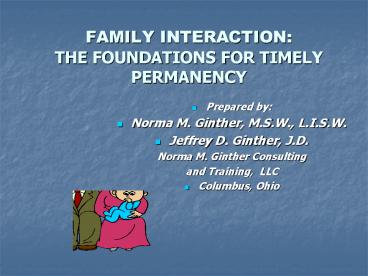FAMILY INTERACTION: THE FOUNDATIONS FOR TIMELY PERMANENCY - PowerPoint PPT Presentation
1 / 18
Title:
FAMILY INTERACTION: THE FOUNDATIONS FOR TIMELY PERMANENCY
Description:
Shock/denial. Anger/protest. Bargaining. Depression. Resolution ... Child's ability to self-care. Family's willingness/ability to get help ... – PowerPoint PPT presentation
Number of Views:120
Avg rating:3.0/5.0
Title: FAMILY INTERACTION: THE FOUNDATIONS FOR TIMELY PERMANENCY
1
FAMILY INTERACTIONTHE FOUNDATIONS FOR TIMELY
PERMANENCY
- Prepared by
- Norma M. Ginther, M.S.W., L.I.S.W.
- Jeffrey D. Ginther, J.D.
- Norma M. Ginther Consulting
- and Training, LLC
- Columbus, Ohio
2
WELCOME
- Why do you see your family?
3
Family Interaction Resources
Hess, P. Proch, K. (1988). Family visiting in
out-of-home care A guide to practice. Pine,
B., Warsh, R., Maluccio, A. (eds.) (1933).
Together again Family reunification in foster
care. National Resource Center for Foster Care
Permanency Planning (2003), in the article
Visiting Between Children in Care and Their
Families A look at Current policy. C.H. Neuman
(1997).
4
FAMILY INTERACTION
- Without family interaction parent/child
relationship deteriorates - Loss greatest emotional trauma
- Reduces negative affects
- Reduces fantasies/fears
- Reduces self-blame
- Immediate, regular, and increased
- Length? age/need for protection
- Least restrictive
- Minimum multiple times per week
5
The Importance of Attachment
Arousal
Relaxation
Security/ Attachment
Child expresses need
Caregiver Meets Need
Fahlberg, Vera I. (1991)
Fahlberg, Vera I. (1991)
6
(No Transcript)
7
Grief Cycle
Shock/denial
Anger/protest
Bargaining
Depression
Resolution
8
Purpose of Family Interaction for the Caseworker
- Reassurance reduce fear of separation
- Assessment observe attachment, develop plan,
teach family, and assess familys progress. - 3. Treatment engage family in active
treatment, test and build attachment. - 4. Documentation Justify return to home or
termination of parental rights.
9
FAMILY INTERACTION FOR CHILDREN
- Keep relationships
- Reduce trauma
- Reduce fantasy
- Reduce fear
- Reduce self-blame
- Need to be normalized
10
Optimizing Family Interaction
- Surest way to assess strengths/needs.
- Teaching tool for caseworkers to model.
- Minimize risk.
- Never do anything for a child, a parent can do.
- Evaluate why children or parents withdraw.
- Keep and encourage family traditions.
- Make lifebooks.
- Caseworkers must assess their commitment level
and why its there. - Specifically recruit foster parents to work with
birth parents.
11
SIBLINGS ARE IMPORTANT
- Place together or in close proximity
- Use sibling placement contracts.
- Assist foster parent with parentified sibling.
- Dont strip the role of the parentified sibling.
12
- AGENCY RESOURCES COMMITTED
- Agency makes sure family interaction takes
place and following guidelines are met - A required well developed, written Family
Interaction plan - Family Interaction held to same level as case
plan - Policy concerning expectations of agency
- Correlate high caseloads and lack of family
interaction - Provide assistance to caseworkers
- Provide varied hours of operation
- A comfortable and relaxed environment
- Offer financial assistance to parents with
limited resources.
13
ASSUMPTIONS
- 1. Agency assures well-planned family
interaction. - 2. Family interaction is not a reward or
punishment. - 3. All planning should involve all members of
the Primary Care Team.
14
Caseworkers Role/Responsibility
- Develop, implement and revise plan.
- Prioritize facilitation of plan.
- Support the parent, foster family and child.
- Inform parent of their responsibilities.
- Assess family attachment and extended family
connection. - Evaluate success of plan.
- Supervise Family Interaction, if needed.
- Work with child and parent over setbacks in plan.
- Provide conflict resolution to the plan.
- Stress to all that safety is sole responsibility
of parent.
15
Parents Role/Responsibility
- Insure emotional and physical safety and
well-being of child. - Provide or support transportation,
- whenever possible.
- Attend Family Interaction as scheduled.
- Call in advance to cancel and discuss
cancellation with child. - Take on parental role to meet childs
- needs.
- Respond to direction during visits.
- Follow agreed-to rules and conditions.
16
Foster Families Role/Responsibility
- Assist or provide transportation of child.
- Have regular on-going contact with parent.
- Permit Family Interaction in foster homes.
- Active in arranging Family Interaction.
- Document behavior before, during, and after.
- Encourage contact and support child.
- Have child ready to participate.
- Pack clothing and other essentials for overnight.
- Help child accept separation from parent life
book opportunities. - Notify caseworker of any unplanned activity that
occurs.
17
CONTACT MUST BE CHILD SPECIFIC
- Childs ability to self-care
- Familys willingness/ability to get help
- Childs request for and reaction to visits
- Divided loyalty/chaos at home
- Developmentally appropriate activities
- Therapeutic needs of child
- Consider childs schedule
18
Phases of Family Interaction
- I. Initial
- II. Middle
- III. Transitional































